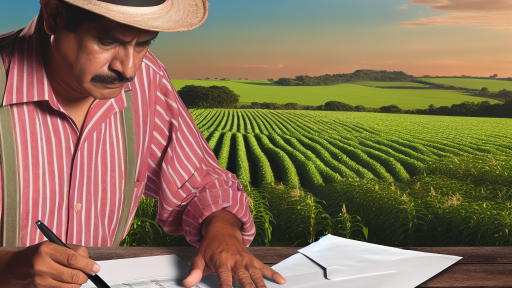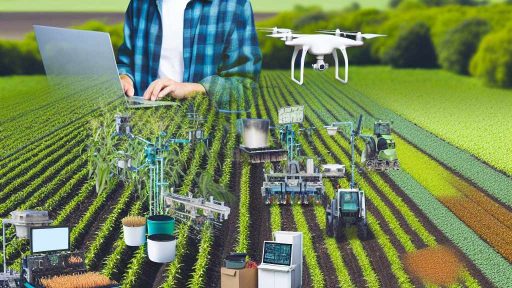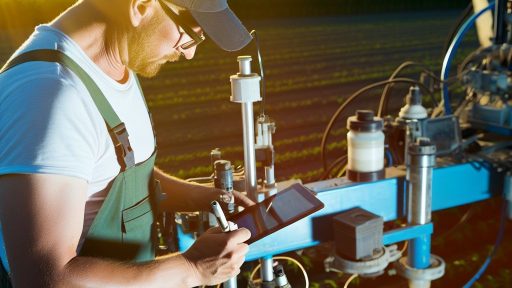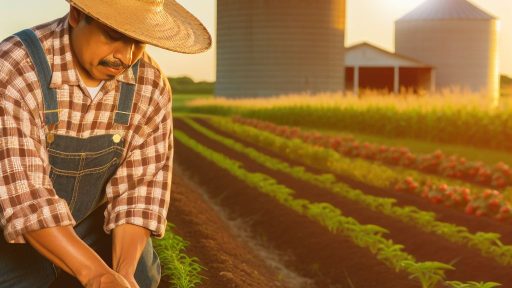Introduction to Farm Diversification and the Role of Technology
Farm diversification involves expanding production beyond traditional single crops or livestock.
This approach reduces risk by allowing farmers to explore various revenue streams.
Moreover, it aligns with sustainable practices, enhancing resilience against market fluctuations.
Technology plays a crucial role in facilitating successful farm diversification.
It offers innovative solutions that streamline farm operations and improve decision-making.
For instance, precision agriculture utilizes data analytics to optimize crop production.
Additionally, IoT devices monitor livestock health, ensuring better animal welfare.
Furthermore, technology enables farmers to experiment with new crops or products.
Farm management software tracks performance metrics and financial data efficiently.
This empowers farmers to make informed choices regarding diversification strategies.
Benefits of Farm Diversification
Diversification enhances farm profitability by capturing various markets.
It provides farmers with the ability to adapt to changing consumer demands.
Additionally, it minimizes the economic impact of crop failures or price drops.
Technology supports diversification by allowing real-time market analysis.
Farmers can quickly pivot their strategies based on market trends.
Transform Your Agribusiness
Unlock your farm's potential with expert advice tailored to your needs. Get actionable steps that drive real results.
Get StartedThe Role of Data in Decision-Making
Data analytics helps farmers identify profitable opportunities for diversification.
Farmers now have access to extensive datasets regarding climate, soil health, and market demands.
Utilizing this information can lead to more targeted and effective farming strategies.
Moreover, cloud computing enables easy sharing of resources and data among farmers.
This collaborative approach fosters innovation and shared learning across communities.
Case Studies of Successful Diversification
Many farms have successfully diversified their operations with the aid of technology.
One notable example is Green Valley Farms, which integrated aquaponics into their model.
This innovation allowed them to cultivate fish alongside vegetables, maximizing space.
Similarly, Sunny Fields adopted agri-tourism, enhancing visibility and revenue.
These examples illustrate how technology and diversification can harmoniously coexist.
Assessing Crop and Livestock Diversification Opportunities Using Data Analytics
The Role of Data Analytics in Agriculture
Data analytics plays a crucial role in modern agriculture.
This technology facilitates informed decision-making for farmers.
Additionally, it enhances the ability to respond to market changes.
Identifying Diversification Opportunities
Farmers can use data analytics to identify potential diversification opportunities.
For example, analyzing market trends reveals profitable crops and livestock.
Moreover, farmers can assess environmental conditions for suitability.
Tools such as GIS mapping provide valuable spatial data.
Utilizing Predictive Analytics
Predictive analytics helps farmers forecast future market demands.
This technology allows for the anticipation of price fluctuations.
Furthermore, farmers can analyze consumer preferences over time.
By doing so, they align their offerings with market needs.
Evaluating Risk and Profitability
Assessing diversification involves evaluating risk and profitability.
Data analytics quantifies potential risks of various crops and livestock.
Farmers can run scenarios to predict outcomes based on historical data.
Showcase Your Farming Business
Publish your professional farming services profile on our blog for a one-time fee of $200 and reach a dedicated audience of farmers and agribusiness owners.
Publish Your ProfileConsequently, they can make evidence-based decisions for their operations.
Integrating Technology for Optimal Results
Integrating various technologies enhances data analytics capabilities.
For instance, IoT devices monitor real-time farm conditions.
This data complements analytics, providing a holistic view of operations.
As a result, farmers can optimize resource allocation effectively.
Case Studies of Successful Diversification
Numerous farms have successfully diversified through data analytics.
For instance, Greenfield Farms used analytics to add organic vegetables.
This move increased their income significantly.
Similarly, Meadowbrook Livestock utilized data to improve breeding programs.
The outcome was enhanced productivity and profitability.
The Impact of Precision Agriculture on Resource Management and Productivity
Enhancing Resource Management
Precision agriculture utilizes technology to optimize resource use.
This approach minimizes waste and environmental impact.
Moreover, farmers can monitor soil health more accurately.
They use sensors and satellite imagery for real-time data collection.
As a result, they can apply fertilizers and water more efficiently.
This efficiency leads to improved crop yields and resource preservation.
Increasing Productivity
Technology enhances productivity through automation and analysis.
Farmers can automate irrigation systems using moisture sensors.
This automation helps in maintaining ideal soil conditions.
Additionally, precision planting techniques ensure optimal seed spacing.
This maximizes sunlight exposure and resource usage.
Consequently, crops grow healthier and produce higher yields.
Data-Driven Decision Making
Data analytics plays a crucial role in precision agriculture.
Farmers analyze historical yields to make informed decisions.
They can predict future crop performance based on current conditions.
Furthermore, farmers track pest and disease patterns with advanced tools.
Timely interventions can significantly reduce losses.
Therefore, data-driven strategies lead to more effective resource allocation.
Fostering Sustainable Practices
Precision agriculture promotes sustainable farming techniques.
Farmers implement practices that protect water and soil health.
For instance, cover cropping improves soil structure and reduces erosion.
Simultaneously, reduced chemical inputs minimize harmful runoff.
Overall, these practices contribute to environmental stewardship.
As a result, the agricultural sector moves towards sustainability.
Learn More: Efficient Irrigation Methods To Reduce Farming Costs
Utilizing IoT Devices for Real-Time Monitoring in Diverse Farm Operations
Introduction to IoT in Agriculture
Internet of Things (IoT) technology revolutionizes how farmers manage operations.
This technology connects devices to the internet for seamless data exchange.
Farmers can access real-time information, enhancing decision-making.
Using IoT, they can monitor crops, livestock, and environmental conditions efficiently.
Implementing IoT Devices
Farmers can select from various IoT devices tailored to specific needs.
Showcase Your Farming Business
Publish your professional farming services profile on our blog for a one-time fee of $200 and reach a dedicated audience of farmers and agribusiness owners.
Publish Your ProfileSensors monitor soil moisture, temperature, and nutrient levels.
These sensors relay data to farmers, allowing for timely interventions.
Additionally, drones can survey large areas, providing aerial insights.
Farmers benefit from improved accuracy in crop health assessments.
Enhancing Operational Efficiency
Real-time data leads to efficient resource management on farms.
Farmers can optimize water usage using smart irrigation systems.
This approach minimizes waste while ensuring crops receive adequate hydration.
IoT technology also helps track livestock health with wearable devices.
Consequently, farmers can promptly address health issues.
Data-Driven Decision Making
IoT devices create a wealth of data for farmers to analyze.
This data enables them to identify trends and make informed decisions.
Farmers can adjust planting schedules based on climatic changes.
Predictive analytics helps forecast yields, improving financial planning.
Challenges and Considerations
Despite their benefits, IoT devices come with challenges.
Farmers must consider initial setup costs and technology maintenance.
Moreover, data privacy and security are critical concerns.
Addressing these challenges is essential for successful implementation.
The Future of IoT in Agriculture
The future of farming lies in adopting innovative technologies.
As IoT technology evolves, more advancements will become available.
Integrating artificial intelligence with IoT will offer even greater insights.
Farmers must stay informed to leverage these technological advancements.
Ultimately, embracing IoT can lead to a more sustainable farming model.
Explore Further: Enhancing Farm Efficiency Through Supply Chain Optimization
Utilizing Farm Management Software for Improved Planning and Decision-Making
Enhancing Farm Operations
Farm management software streamlines daily operations effectively.
It provides farmers with real-time data for better insights.
Consequently, this software aids in making timely decisions.
For example, improved inventory tracking saves time and resources.
Improving Financial Management
Effective financial management is crucial for farm sustainability.
Software tools assist in budgeting and forecasting efficiently.
These tools provide clarity on revenue and expenses.
Farmers can identify profitable areas quickly.
Facilitating Crop and Livestock Management
Farm management software supports crop planning and monitoring.
This includes tracking growth cycles and input use.
Additionally, it helps in managing livestock health records.
Farmers can maintain optimal feeding and breeding schedules.
Enhancing Reporting and Compliance
With farm management software, reporting becomes simpler.
Farmers generate accurate reports for regulatory compliance effortlessly.
This reduces the risk of penalties and enhances transparency.
Moreover, software can track environmental practices effectively.
Integrating Technology for Data Analysis
Data analysis features provide valuable insights for decision-making.
Showcase Your Farming Business
Publish your professional farming services profile on our blog for a one-time fee of $200 and reach a dedicated audience of farmers and agribusiness owners.
Publish Your ProfileFarmers can monitor market trends in real time.
This information aids in selecting the right crops or livestock.
Furthermore, analyzing historical data supports strategic planning.
Supporting Collaboration and Communication
Farm management software promotes collaboration among team members.
Real-time updates enhance communication within farming operations.
This fosters teamwork and efficiency across the board.
Additionally, cloud capabilities allow access from any location.
Delve into the Subject: Budgeting Tips For Sustainable Farming Practices
Adopting Sustainable Practices through Technology
Integrating Smart Farming Techniques
Sensors play a crucial role in smart farming operations.
They monitor soil moisture and crop health effectively.
Farmers gain real-time data to make informed decisions.
This technology reduces water waste significantly.
Additionally, it optimizes nutrient usage in fields.
Consequently, yields improve without harming the environment.
Embracing Precision Agriculture
Precision agriculture enhances resource management on farms.
GPS technology assures accurate field mapping.
Farmers can tailor treatments based on specific needs.
As a result, they minimize excess input costs.
Furthermore, this approach boosts sustainability in farming.
Farmers can monitor their fields remotely using drones.
Drones provide aerial views and detailed crop assessments.
Utilizing Data Analytics for Decision Making
Data analytics aids in predicting crop performance trends.
Farmers analyze historical data for future planting strategies.
This method allows for smarter crop rotations.
Furthermore, it identifies potential pest outbreaks early.
Timely interventions lead to efficient pest management.
Resource allocation becomes more efficient with data insights.
Engaging with Community and Market Platforms
Technology connects farmers directly to consumers.
Online platforms facilitate direct sales channels.
Working collaboratively, farmers can diversify their offerings.
This strategy enhances community engagement and support.
Additionally, it opens up new markets for niche products.
Through technology, diversification strategies become more viable.
Gain More Insights: Maximizing Crop Yields While Minimizing Costs
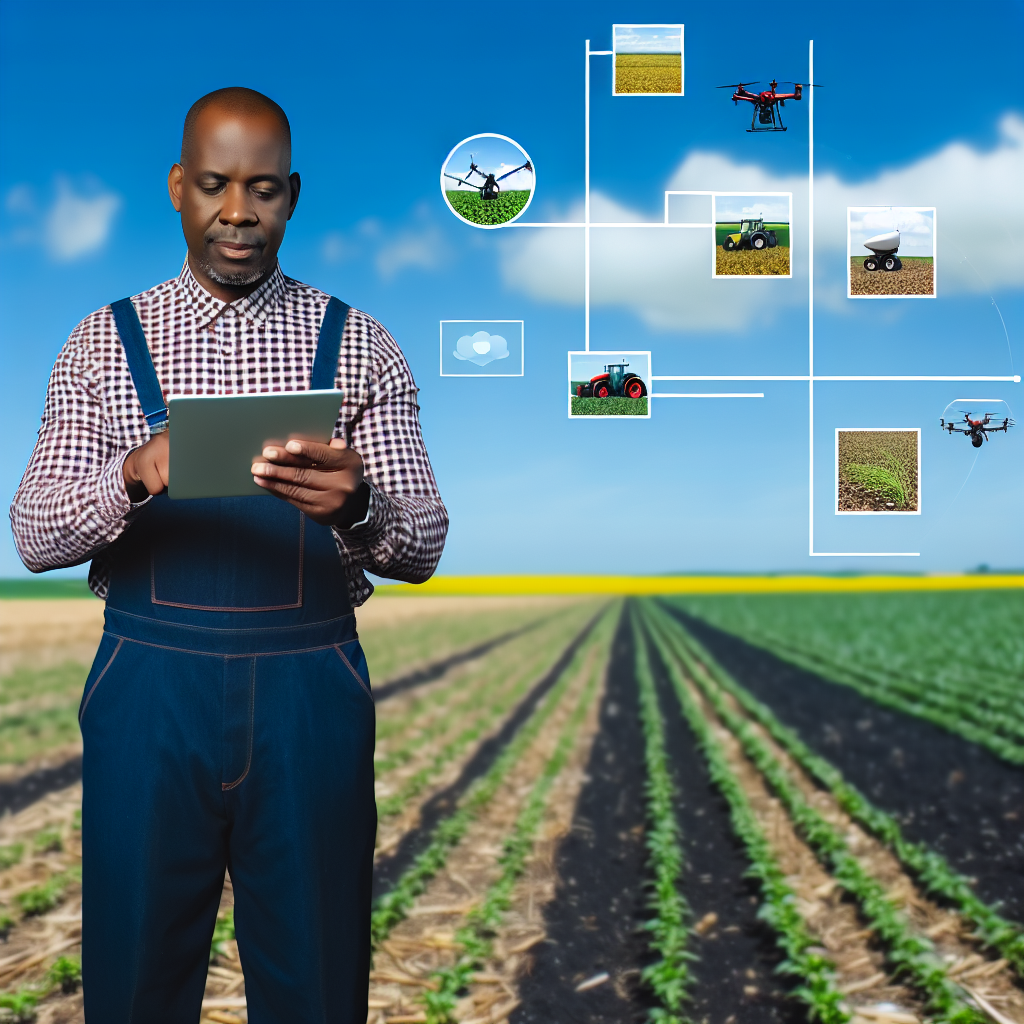
Exploring the Benefits of Drones for Crop Surveillance and Livestock Tracking
Enhancing Crop Surveillance
Drones offer a unique advantage in crop surveillance.
Farmers can monitor large fields from the sky efficiently.
This technology saves time and energy compared to traditional methods.
With high-resolution cameras, drones capture detailed images of crops.
Farmers identify problem areas quickly and accurately.
They can observe plant health and spot diseases early.
Showcase Your Farming Business
Publish your professional farming services profile on our blog for a one-time fee of $200 and reach a dedicated audience of farmers and agribusiness owners.
Publish Your ProfileThis proactive approach minimizes potential crop loss.
Improving Livestock Tracking
Drones also play a significant role in livestock management.
These devices provide real-time data on animal locations.
Farmers can monitor herds in hard-to-reach areas effectively.
This technology reduces labor costs and enhances efficiency.
Moreover, aerial imagery helps ensure livestock safety and well-being.
Farmers can assess grazing patterns and health conditions.
Cost-Effectiveness and Efficiency
Utilizing drones for surveillance is cost-effective.
This technology reduces the need for extensive manual labor.
Also, it limits the resources required for traditional surveillance methods.
Farms can lower operational costs while increasing productivity.
Farmers experience faster decision-making with timely data.
Increased Data Collection
Drones facilitate data collection in agriculture.
They gather multispectral data for soil analysis and crop health.
This information helps farmers make informed management choices.
For example, they can optimize irrigation and fertilization strategies.
Thus, drone technology supports data-driven farming practices.
Case Studies of Successful Farms Utilizing Technology for Diversification
Innovative Livestock Farming
The Green Valley Farms exemplifies successful livestock diversification.
They integrate blockchain technology for transparent supply chain management.
This technology enhances product traceability and consumer trust.
Additionally, they utilize drones for monitoring livestock health.
These measures significantly reduce operational costs.
As a result, their farm efficiency has improved markedly.
Crop Rotation with Precision Agriculture
Sunny Acres employs precision agriculture for crop diversification.
The farm uses sensors to collect soil data accurately.
This data guides crop selection for optimal yield and health.
Moreover, they apply variable rate technology for fertilizer application.
This method minimizes waste and environmental impact.
Consequently, Sunny Acres has significantly increased production variety.
Integrating Agri-tech Startups
Mainstream Farming collaborates with innovative agri-tech startups.
These partnerships enhance their diversification strategies.
For instance, they use machine learning to predict crop trends.
This data-driven approach leads to smarter planting decisions.
Additionally, they implement automated irrigation systems.
This solution conserves water and improves crop resilience.
Adopting Sustainable Practices
Eco-Friendly Farms focuses on sustainable technology for diversification.
They employ solar energy systems to power operations.
This not only reduces costs but also supports environmental goals.
The farm promotes agroforestry practices to enhance biodiversity.
Such initiatives contribute to ecosystem health and farm income.
Showcase Your Farming Business
Publish your professional farming services profile on our blog for a one-time fee of $200 and reach a dedicated audience of farmers and agribusiness owners.
Publish Your ProfileConsequently, Eco-Friendly Farms remains competitive in the market.
Utilizing E-commerce for Market Expansion
Harvest Direct leverages e-commerce for broader market access.
Their online platform connects directly with consumers.
This strategy diversifies their sales channels significantly.
Furthermore, they utilize data analytics to understand consumer preferences.
This knowledge drives product development and marketing efforts.
As a byproduct, customer engagement has dramatically increased.
Future Trends in Technology That Could Enhance Farm Diversification Strategies
Precision Agriculture
Precision agriculture utilizes data-driven techniques to improve crop yields.
Farmers can use GPS technology to optimize planting and harvesting.
This approach reduces waste and enhances resource efficiency.
Moreover, farmers can monitor soil health using smart sensors.
Real-time data enables informed decisions about crop selections.
Automation and Robotics
Automation streamlines various farm operations.
Robotic machinery can assist in planting, watering, and harvesting.
This innovation frees up labor, allowing farmers to explore new ventures.
For example, drones can assess crop health and irrigation needs.
As a result, farmers can diversify their operations efficiently.
Blockchain Technology
Blockchain offers transparency in the agricultural supply chain.
Farmers can authenticate product origins and enhance consumer trust.
This technology facilitates direct sales to consumers, increasing profits.
Furthermore, it can help track supply chain inefficiencies.
By identifying bottlenecks, farmers can adapt their diversification strategies.
Vertical Farming Innovations
Vertical farming maximizes space use in urban environments.
It allows farmers to grow fresh produce year-round.
This method minimizes land use and transportation costs.
Farmers can combine traditional crops with specialty items.
Consequently, this flexibility can attract diverse customer bases.
Sustainable Practices with IoT
The Internet of Things (IoT) connects devices for efficient monitoring.
Farmers can track weather patterns and soil conditions remotely.
This technology aids in making better farming decisions.
Additionally, IoT can reduce water usage and energy waste.
By embracing sustainable practices, farmers can enhance diversification.
Additional Resources
Farm diversification, entrepreneurship and technology adoption …
USDA Science and Research Strategy, 2023-2026: Cultivating …

